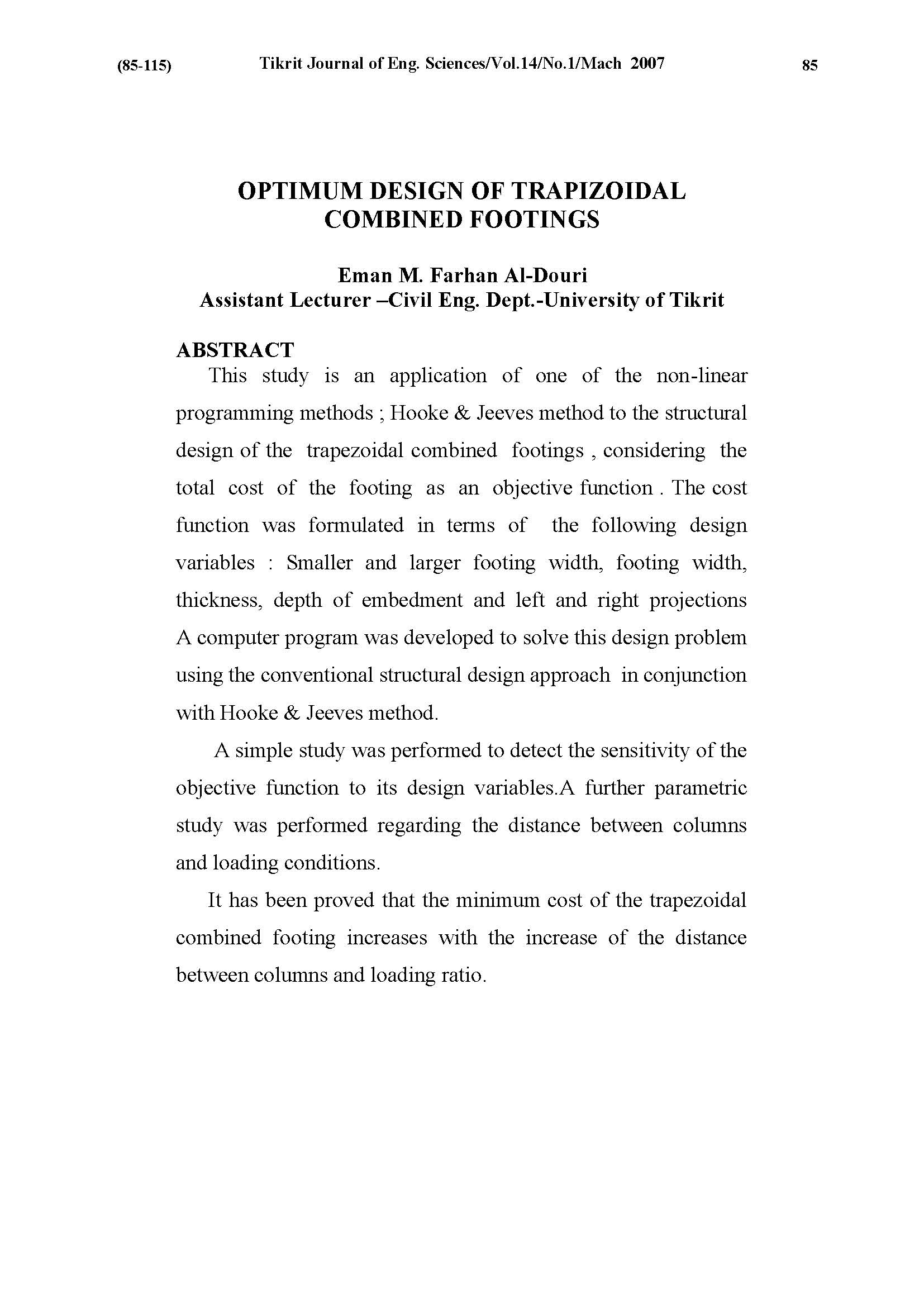Optimum Design of Trapezoidal Combined Footings
Main Article Content
Abstract
This study is an application of one of the non-linear programming methods ; Hooke & Jeeves method to the structural design of the trapezoidal combined footings , considering the total cost of the footing as an objective function . The cost function was formulated in terms of the following design variables : Smaller and larger footing width, footing width, thickness, depth of embedment and left and right projections A computer program was developed to solve this design problem using the conventional structural design approach in conjunction with Hooke & Jeeves method. A simple study was performed to detect the sensitivity of the objective function to its design variables.A further parametric study was performed regarding the distance between columns and loading conditions. It has been proved that the minimum cost of the trapezoidal combined footing increases with the increase of the distance between columns and loading ratio.
Metrics
Article Details

This work is licensed under a Creative Commons Attribution 4.0 International License.
THIS IS AN OPEN ACCESS ARTICLE UNDER THE CC BY LICENSE http://creativecommons.org/licenses/by/4.0/
Plaudit
References
Kuester, J.L. and Mize, J., (1973), “ Optimization Techniques with Fortran”, McGraw Hill BookCompany.
Bowles, J.E.(1974), “Analytical and Computer Methods in Foundation Engineering ”, McGraw HillBook Company.
Rao, S.S. (1979), “Optimization Theory and Applications”, Wiley Estern Limited, New Delhi.
Bowles, J.E.(1982), “ Foundation Analysis andDesign”, McGraw Hill Book Company.
Naaman, A.E.(1982),“ Optimum Design of Prestressed Concrete Tension Members”, ASCE, Vol. 108, No.8,pp. 1722-1738. DOI: https://doi.org/10.1061/JSDEAG.0006014
Bundy, B.D, (1984), “ Basic Optimization Methods”, Eduard Arnold Publishers.
Desai, I.D., Desai, G.N. and Desai, T.B., (1984),“ Cost Optimization of Isolated Sloped Footing in Granular Medium”,Proceedings of Iraqi Conference on Engineering , ICE 1985 , Vol.1, pp. 102-108.
Namiq , L.I. and Al-Ani, M.M., (1985), “Optimum Design of Spread Footings Subjectedto Axial and Biaxial Moments”, ICE, Vol.1, pp.8-12.
Brandt, A.M., Dzieniszewski, W., Jendo, S., Marks, W., Owezarek, S. and Wasiutynski, Z.,(1986), “ Criteria and Methods of Structural Optimization”, Martinus Nijhoff Publishers. DOI: https://doi.org/10.1007/978-94-011-7517-3
Freguson , P.M., Breen, J.E. and Jirso,J.O.,(1988), “ Reinforced Concrete Fundamentals”, John Wiley & Sons, Inc., FifthEdition New York.
ACI Committee 318-89, (1989), “ Building Code Requirements for Reinforced Concrete”, ACI,Detroit.
Bowles, J.E., (1989), “ Foundation Analysis andDesign”, McGraw Hill Book Company.
Al- Jubair , H.S., (1994), “ Economical Design of Ring Foundations”, Al- Muhandis Journal of The Scientific Society Vol. 120, No.4, pp. 45-54.
Al- Douri , E. M.,(1999), “ Optimum Design ofRectangular Combined Footings”, M.Sc. Thesis,Tikrit University.
Al-Jubori , A. M.,(2001), “ Optimum Design of Raft Foundations”, M.Sc. Thesis, TikritUniversity.





